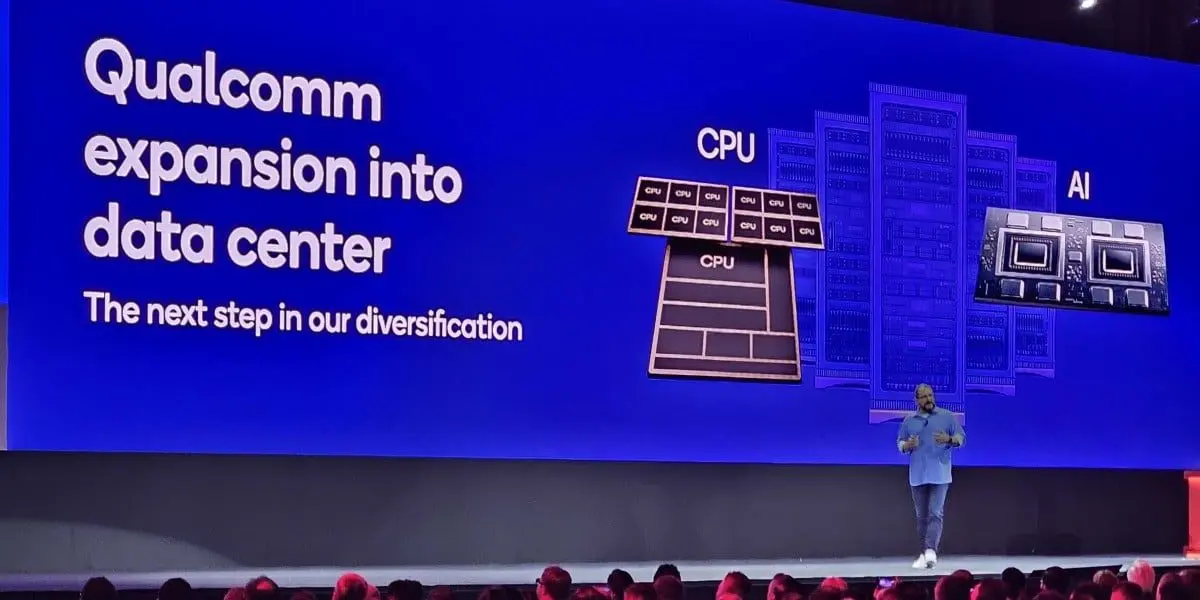Qualcomm Poaches Intel Veteran to Lead Data Center CPU Development, Challenging AMD and Intel in AI-Driven Market
2 Sources
2 Sources
[1]
Qualcomm poaches Xeon chief architect to compete better with AMD and Intel in AI data center CPU market
But that didn't stop Qualcomm from bringing him onboard to lead its data center team Qualcomm, renowned for its Snapdragon processors powering business smartphones and laptops around the world, has made a potentially key hire as it looks to challenge the likes of AMD and Intel in the processor market. The company's latest coup is hiring Sailesh Kottapalli, a former chief architect for Xeon processors and a 28-year Intel veteran. Kottapalli joined Qualcomm as senior vice president in early January 2025, bringing extensive expertise in designing high-performance x86 server chips. Kottapalli wrote on LinkedIn that "the opportunity to innovate and grow while helping to scale new frontiers was immensely compelling to me -- a once-in-a-career opportunity that I could not pass on." What makes the move significant, given Qualcomm's reliance on Arm-based designs, is Kottapalli's expertise in x86 architecture. His leadership could help bridge the gap between Qualcomm's existing technology and the demanding requirements of data center CPUs. Qualcomm had retreated from server CPU development back in 2018, but the company has now revealed plans to develop high-performance, energy-efficient server solutions tailored for data center applications. This journey began with its Snapdragon X series for PCs, featuring custom Arm-based cores derived from its $1.4 billion acquisition of the startup Nuvia back in 2021, that built to a legal crescendo in a Delaware court in December 2024 when Arm alleged that Qualcomm's acquisition breached its licencing terms. Though a federal jury sided with Qualcomm, Arm is seeking a retrial. For now, though, Qualcomm has been expanding its presence in the data center sector, with AI accelerator chips under the Qualcomm Cloud AI brand supported by industry leaders like AWS, HPE, and Lenovo.
[2]
Qualcomm Is Going After Intel and AMD in This Lucrative Market | The Motley Fool
The server CPU market has long been dominated by Intel (INTC 2.71%) and AMD (AMD 3.33%). Both companies make chips based on the x86 architecture. While there are other types of CPUs used for specialized purposes -- think IBM mainframes -- x86 reigns supreme in the data center. Software is compiled and optimized for x86 chips, which creates significant switching costs. Qualcomm (QCOM 3.06%) has already tried and failed once to bring chips based on the Arm architecture, which dominates the smartphone market, to the server market. Qualcomm's Centriq server CPUs failed to gain any traction when they were launched in late 2017, leading the company to greatly scale back its efforts. Switching to Arm-based chips or mixing-and-matching architectures just wasn't worth the effort for any major server CPU customer. Qualcomm launched its first Arm-based PC CPUs last year, and although they haven't exactly been a smash hit, partly because of compatibility problems, Arm-based PC are likely to be here to stay. Qualcomm is now seemingly looking to re-enter the server CPU market with new chips. According to a LinkedIn post, Intel veteran and a chief architect of the Xeon server processor family Sailesh Kottapalli is joining Qualcomm after nearly three decades at Intel. In December, Qualcomm disclosed in a job posting that its data center team was working on server products for data center applications. Kottapalli is expected to lead that effort. While Qualcomm's PC chips have issues running certain types of applications, particularly games, using emulation, they provide solid performance and efficiency. Qualcomm can build on that work to go after the data center market. Back in 2018, Qualcomm had little chance of success with its Centriq server CPUs. There was too much inertia behind x86, and the software ecosystem was centered around the dominant architecture. Qualcomm might have better luck this time around thanks to artificial intelligence. Tech giants like Microsoft are spending mountains of money building brand new AI datacenters, and some are even designing their own Arm-based CPUs. The software stack is still evolving, and with Microsoft, Amazon, and others now getting behind Arm-based server CPUs, there's a lot more momentum in 2025 than there was in 2018. While the environment is more welcoming for Qualcomm, the company will face competition from potential customers' in-house chip design efforts as well as any other company that jumps into the market. Nvidia already sells its Grace family of data center CPUs based on the Arm architecture, and others could follow as Arm gains more traction. While Intel and AMD will face more competition if Qualcomm reenters the server CPU market, both companies have solid product lineups that will be tough to beat. Intel improved its competitive positioning last year with its powerful Granite Rapids chips and efficiency-focused Sierra Forest chips, and this year it plans to use its cutting-edge Intel 18A manufacturing process for Clearwater Forest. Meanwhile, AMD officially launched its Turin family of server CPUs in October, which goes up to 192 cores. Included in the lineup is a CPU specially designed to act as the host node CPU for a cluster of AI accelerators. AMD's last-generation server CPUs were a big hit, and the company will look to build on that progress. Qualcomm appears to be gearing up to try again in the server CPU market. This time should go better than last time as the environment is far more conducive to Arm-based CPUs, but competition will be fierce.
Share
Share
Copy Link
Qualcomm hires former Intel Xeon chief architect Sailesh Kottapalli to spearhead its re-entry into the server CPU market, aiming to compete with AMD and Intel in the evolving AI-centric data center landscape.

Qualcomm's Strategic Move in the Data Center CPU Market
Qualcomm, a company renowned for its Snapdragon processors in smartphones and laptops, is making a bold move to challenge AMD and Intel in the lucrative data center CPU market. The company has hired Sailesh Kottapalli, a former chief architect for Intel's Xeon processors and a 28-year veteran of the company, as senior vice president to lead its data center team
1
2
.The Significance of Kottapalli's Hire
Kottapalli's expertise in designing high-performance x86 server chips is particularly noteworthy given Qualcomm's traditional reliance on Arm-based designs. This strategic hire could potentially bridge the gap between Qualcomm's existing technology and the demanding requirements of data center CPUs
1
.Kottapalli expressed his enthusiasm for the role on LinkedIn, stating, "The opportunity to innovate and grow while helping to scale new frontiers was immensely compelling to me -- a once-in-a-career opportunity that I could not pass on"
1
.Qualcomm's Data Center Ambitions
This move signals Qualcomm's renewed interest in the server CPU market, a sector it had previously retreated from in 2018. The company has now revealed plans to develop high-performance, energy-efficient server solutions tailored for data center applications
1
.Qualcomm's journey in this direction began with its Snapdragon X series for PCs, featuring custom Arm-based cores derived from its $1.4 billion acquisition of Nuvia in 2021. However, this acquisition led to legal challenges from Arm, alleging breach of licensing terms, which culminated in a federal jury siding with Qualcomm in December 2024
1
.Related Stories
The Changing Landscape of Server CPUs
The server CPU market has long been dominated by Intel and AMD with their x86 architecture. However, the landscape is evolving, particularly due to the rise of artificial intelligence. Tech giants like Microsoft and Amazon are now investing heavily in AI data centers and even designing their own Arm-based CPUs
2
.This shift creates a more welcoming environment for Arm-based server CPUs in 2025 compared to 2018. The evolving software stack and increased momentum behind Arm architecture in the data center space could potentially give Qualcomm a better chance of success this time around
2
.Challenges and Competition
Despite the more favorable conditions, Qualcomm will face significant challenges. Competition will come not only from established players like Intel and AMD but also from potential customers' in-house chip design efforts and other new entrants to the market. Nvidia, for instance, already sells its Grace family of data center CPUs based on the Arm architecture
2
.Intel and AMD are not standing still either. Intel has improved its competitive positioning with its Granite Rapids and Sierra Forest chips, while AMD recently launched its Turin family of server CPUs, which includes a CPU specially designed for AI accelerator clusters
2
.As Qualcomm gears up for this ambitious endeavor, the data center CPU market is poised for increased competition and innovation, driven by the growing demands of AI and cloud computing.
References
Summarized by
Navi
[1]
Related Stories
Recent Highlights
1
OpenAI declares code red as Google's Gemini gains 200 million users in three months
Technology

2
DeepSeek releases open-source AI models that rival GPT-5 and Gemini at fraction of the cost
Technology

3
AI Chatbots Sway Voters More Effectively Than Traditional Political Ads, New Studies Reveal
Science and Research








